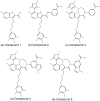Prediction of Hot Spots at Myeloid Cell Leukemia-1-Inhibitor Interface Using Energy Estimation and Alanine Scanning Mutagenesis
- PMID: 29345906
- PMCID: PMC6203182
- DOI: 10.1021/acs.biochem.7b01048
Prediction of Hot Spots at Myeloid Cell Leukemia-1-Inhibitor Interface Using Energy Estimation and Alanine Scanning Mutagenesis
Abstract
Myeloid cell leukemia 1 (Mcl1) is an antiapoptotic protein that plays central role in apoptosis regulation. Also, Mcl1 has the potency to resist apoptotic cues resulting in up-regulation and cancer cell protection. A molecular probe that has the potential to specifically target Mcl1 and thereby provoke its down-regulatory activity is very essential. The aim of the current study is to probe the internal conformational dynamics of protein motions and potential binding mechanism in response to a series of picomolar range Mcl1 inhibitors using explicit-solvent molecular dynamics (MD) simulations. Subsequently, domain cross-correlation and principal component analysis was performed on the snapshots obtained from the MD simulations. Our results showed significant differences in the internal conformational dynamics of Mcl1 with respect to binding affinity values of inhibitors. Further, the binding free energy estimation, using three different samples, was performed on the MD simulations and revealed that the predicted energies (ΔGmmgbsa) were in good correlation with the experimental values (ΔGexpt). Also, the energies obtained using all sampling models were efficiently ranked. Subsequently, the decomposition energy analysis highlighted the major energy-contributing residues at the Mcl1 binding pocket. Computational alanine scanning performed on high energy-contributing residues predicted the hot spot residues. The dihedral angle analysis using MD snapshots on the predicted hot spot residue exhibited consistency in side chain conformational motion that ultimately led to strong binding affinity values. The findings from the present study might provide valuable guidelines for the design of novel Mcl1 inhibitors that might significantly improve the specificity for new-generation chemotherapeutic agents.
Conflict of interest statement
The authors declare no competing financial interest.
Figures














Similar articles
-
Predicted Hotspot Residues Involved in Allosteric Signal Transmission in Pro-Apoptotic Peptide-Mcl1 Complexes.Biomolecules. 2020 Jul 28;10(8):1114. doi: 10.3390/biom10081114. Biomolecules. 2020. PMID: 32731448 Free PMC article.
-
Unraveling the molecular mechanism of benzothiophene and benzofuran scaffold-merged compounds binding to anti-apoptotic Myeloid cell leukemia 1.J Biomol Struct Dyn. 2019 May;37(8):1992-2003. doi: 10.1080/07391102.2018.1474805. Epub 2018 Dec 10. J Biomol Struct Dyn. 2019. PMID: 29745292
-
A multitier virtual screening study of phytoconstituents as Myeloid Cell Leukemias 1 inhibitors.J Biomol Struct Dyn. 2024 Jul;42(10):5219-5228. doi: 10.1080/07391102.2023.2226739. Epub 2023 Jul 7. J Biomol Struct Dyn. 2024. PMID: 37418235
-
Current Tools and Methods in Molecular Dynamics (MD) Simulations for Drug Design.Curr Med Chem. 2016;23(34):3909-3924. doi: 10.2174/0929867323666160530144742. Curr Med Chem. 2016. PMID: 27237821 Review.
-
Unraveling hot spots in binding interfaces: progress and challenges.Curr Opin Struct Biol. 2002 Feb;12(1):14-20. doi: 10.1016/s0959-440x(02)00283-x. Curr Opin Struct Biol. 2002. PMID: 11839484 Review.
Cited by
-
Experimental, molecular docking and molecular dynamic studies of natural products targeting overexpressed receptors in breast cancer.PLoS One. 2022 May 10;17(5):e0267961. doi: 10.1371/journal.pone.0267961. eCollection 2022. PLoS One. 2022. PMID: 35536789 Free PMC article.
-
Effect of double mutations T790M/L858R on conformation and drug-resistant mechanism of epidermal growth factor receptor explored by molecular dynamics simulations.RSC Adv. 2018 Nov 29;8(70):39797-39810. doi: 10.1039/c8ra06844e. eCollection 2018 Nov 28. RSC Adv. 2018. PMID: 35558225 Free PMC article.
-
Identification of the retinoschisin-binding site on the retinal Na/K-ATPase.PLoS One. 2019 May 2;14(5):e0216320. doi: 10.1371/journal.pone.0216320. eCollection 2019. PLoS One. 2019. PMID: 31048931 Free PMC article.
-
Predicted Hotspot Residues Involved in Allosteric Signal Transmission in Pro-Apoptotic Peptide-Mcl1 Complexes.Biomolecules. 2020 Jul 28;10(8):1114. doi: 10.3390/biom10081114. Biomolecules. 2020. PMID: 32731448 Free PMC article.
-
Targeting COVID-19 pandemic: in silico evaluation of 2-hydroxy-1, 2-diphenylethanone N(4)-methyl-N(4)-phenylthiosemicarbazone as a potential inhibitor of SARS-CoV-2.Struct Chem. 2022 Oct 17:1-17. doi: 10.1007/s11224-022-02033-8. Online ahead of print. Struct Chem. 2022. PMID: 36274924 Free PMC article.
References
-
- Reed J. C.; Miyashita T.; Takayama S.; Wang H. G.; Sato T.; Krajewski S.; Aime-Sempe C.; Bodrug S.; Kitada S.; Hanada M. (1996) BCL-2 family proteins: regulators of cell death involved in the pathogenesis of cancer and resistance to therapy. J. Cell. Biochem. 60, 23–32. 10.1002/(SICI)1097-4644(19960101)60:1<23::AID-JCB5>3.0.CO;2-5. - DOI - PubMed
Publication types
MeSH terms
Substances
LinkOut - more resources
Full Text Sources
Other Literature Sources

